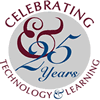PublicationsMining Movies - Technology and Learning Magazine |
||
 |
Artificial Intelligence is One HAL of a Teacher2001: A Space Odyssey is one of those truly visionary movies that most of us managed to appreciate, but were forced to admit we didn’t really understand. Like many people, I saw it twice to make sure the movie reels hadn’t been played out of sequence the first time I watched it. However, almost forty years later, 2001 sticks with us because it was bold, challenging and provided a stereotype of everything that could go wrong with a computer: HAL. HAL was a talking computer that controlled all the functions of an entire spaceship. In “his” spare time he played chess with one of the crewmembers, gave him feedback on his drawings, and was genuinely helpful -- until it felt threatened. One day HAL, the perfect machine, made a mistake. Nothing big, but enough to make the astronauts aboard ship decide to shut him down. Because HAL could see and hear everything, the astronauts had to plot his demise behind closed doors. But surprise - HAL could read lips. As he watched them talk through a window, HAL didn’t like what he heard, and began to eliminate the humans, one by one. HAL gets such a bad rap that we forget the opportunity he offers education: truly sophisticated artificial intelligence (AI) that can help students in many areas, from chess to drawing to speech. A full grown HAL may be far off, but infant versions are already used to “understand” and mentor students in many areas. Outside education, AI is used by stockbrokers, doctors, and scientists. We should expect AI capabilities in many areas to merge and ultimately form an integrated HAL who can watch a classroom, answer questions on many topics in many languages, and recognize and remediate behavioral and learning dysfunctions. In a future in which students’ interests will greatly out-pace a teacher’s knowledge domain, AI mentors will become a teacher’s best friend. Let’s hope they are more human-friendly than HAL. |
|
© 2024 jason ohler |
||


